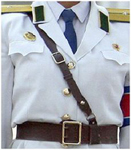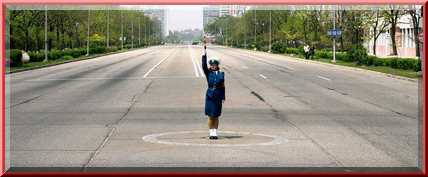Short thesis as to ranks of the traffic policeI have read that the North Korean army ranks were loosely based on the old Soviet system.
Some info on Soviet ranks:
http://www.enotes.com/topic/Military_ranks_of_the_Soviet_UnionSome info on North Korean army ranks:
http://en.wikipedia.org/wiki/Comparative_military_ranks_of_KoreaOn a uniform, the shoulder board shows the rank of the wearer.
Components of the shoulder boards of the traffic police:
1. The shoulder board itself, a plain black color.
2. Gold stripes - perpendicular stripes placed on the shoulder board, worn nearest the body.
3. Gold bars - wide gold bars running the length of the shoulder board.
4. Stars - from 1 to 3 stars placed on a shoulder board with the wide gold bars.
There are hundreds of pictures of Pyongyang traffic police available on the internet.
Of all the pictures of the current era* North Korean traffic police I have ever found, I have only observed 5 different ranks:

1. Plain shoulder board with 2 stripes.
2. Plain shoulder board with 3 stripes.
3. Shoulder board with 2 gold bars and 1 star.
4. Shoulder board with 2 gold bars and 2 stars.
5. Shoulder board with 2 gold bars and 3 stars.
Rank designation of traffic police shoulder boards.....
The military has many tiers of ranking, as can be observed from the previous links. But the traffic police is not exactly the military(more on this later), it is a smaller civilian corps, so they would probably not have need for as many ranks.
In this German film, "Mission North Korea":
http://www.alongmekong.com/videos/nokoGeo.htm A Pyongyang traffic girl with 2 solid bars 1 star is referred to as Major.
My initial thought was that the rank of Major seemed a little high for a 2 bar 1 star police officer, since there are only 2 observed ranks below that. The three stripe shoulderboard, which is universally recognized as sergeant, is the next lower rank. There are missing ranks between Sergeant and Major - if the film were correct in describing the 2 bar 1 star rank as Major. Considering the ambiguities of language translation and re-translation, I think it is an incorrect interpretation of the rank.
So, based on the above observations, and also using Wikipedia's Korea comparative military ranks as a guide, here is an order list as to Pyongyang Traffic Girl rank, with North Korean pronunciation and general Western ranking equivalent name:
Ranks of the Pyongyang Traffic Girls
1. Plain shoulder board with 2 stripes = Chungŭp-pyŏngsa = Corporal

2. Plain shoulder board with 3 stripes = Sanggŭp-pyŏngsa = Sergeant

3. Shoulder board with 2 gold bars and 1 star = Sowi = Junior Lieutenant

4. Shoulder board with 2 gold bars and 2 stars = Jungwi = Lieutenant

5. Shoulder board with 2 gold bars and 3 stars = Daewi = Captain
Note: The North Korean names for the above ranks is based on NK military ranks. The NK Police Force may very well have different names for the various ranks.
Lesser ranksAs stated before, I have never observed on a NK traffic officer a ranking less than the plain shoulder board with 2 stripes - Chungŭp-pyŏngsa, or Corporal. That doesn't mean there is not a lesser ranking.
Perhaps lesser ranking traffic police are in training( traffic police "boot camp"?) until they achieve Chungŭp-pyŏngsa, in which case they would be ready for public traffic duty.
Here is a guess as to what would be the lesser ranks, if they exist, using the previous ranking criteria:

a. Shoulder board with no stripes = Chŏnsa = Private Second Class
b. Plain shoulder board with 1 stripe = Hagŭp-pyŏngsa = Private first Class
I have also never observed a Pyongyang traffic director with a ranking higher than the shoulder board with 2 gold bars and 3 stars - Sangwi, or Captain.
Even on the traffic police chosen to meet VIPs like Chinese ambassadors, or appear in propaganda videos, the highest rank observed is 2 bars 3 stars.
Conjecture on why traffic directors rank no higher than captain:
Ranks higher than Captain are beyond performing traffic duty.
Or also, considering the fact that the traffic girls face mandatory retirement from traffic directing duties at age 26, it's also likely that one would not advance beyond Captain at so young an age.
Higher RanksSo the Traffic police directing traffic have only been observed as having one of the 5 ranks mentioned above. And I have speculated that there may be 2 lower ranks that are rarely seen out in public.
The highest rank
observed directing traffic is the 2 bar 3 star rank, or Captain.
But look at this picture of a group of off-duty traffic girls who are performing crosswalk maintenance:
(click image for larger view.)

In the background you can see some crusty old guy in a white traffic police uniform who appears to be overseeing them.
Now observe the shoulderboard on Mr. Crusty.

It is a three bar, one star shoulderboard - The highest rank I have ever observed on a traffic police officer.
So here is a sixth observed rank for the traffic police, although a rank that is in all probability never assigned to directing traffic:

6. Shoulder board with 3 bars 1 star = Sojwa = Major.
There are several videos from North Korea featuring stories or news about the Pyongyang Traffic Girls, where men in army-style uniforms are seen in meetings with the traffic girls, or are seen leading them, or are interviewed about the traffic girls. Some screencaps:
Could this indicate that the traffic police, or the police in general, are ultimately under control of the military? The shoulder boards on these army-style men are 3 bars with 1 - 3 stars.

7. Shoulderboard with 3 bars 2 stars = Jungjwa = Lieutenant Colonel

8. Shoulderboard with 3 bars 2 stars = Sangjwa = Colonel
Would there be a Colonel, or even General, of police officers?
Where do the traffic police fit in the hierarchy of the North Korean command structure?
From http://en.wikipedia.org/wiki/Law_enforcement_in_North_Korea :
The Ministry of Public Security - responsible for internal security, social control, and basic police functions controls an estimated 144,000 public security personnel.
The ministry has several vice ministers in charge of approx 27-40 different bureaus. Two of the bureaus are:
* The Security Bureau - responsible for ordinary law enforcement and most police functions.
* The Protection Bureau - responsible for fire protection, traffic control, public health, and customs.
Below the ministry level, there are public security bureaus for each province and directly administered city. These bureaus are headed by either a senior colonel or a lieutenant colonel
Summary:
Ministry Of Public Security > Protection Bureau > Pyongyang public security buearu > traffic control > Pyongyang Traffic Girls
Older style shoulderboardsOn pictures of traffic police taken before the current era*, the uniforms and shoulder boards were of a different style.
Some pictures:






On these examples they have 2-4 gold stripes, and except for pictures #2 and #6, there is a gold bar down the middle. My guess is that the 3 stripe 1 bar shoulder board shows the rank of Daewi, or Captain.
* * * * * * * * * * * * * * * * * * * * * * *
Additional note:
All traffic officer uniforms with a rank of Sowi ( Junior Lieutenant) or higher feature the leather diagonal strap,
commonly known as a
Sam Browne belt. 
Lesser ranks never wear the Sam Browne belt.
*current era - since about the early 2000's, when the present shoulder board style appeared.


